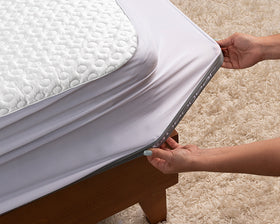888-996-9890

What is a Waterbed?
Sleeping on Water
Most mattresses are filled with an innerspring system, a foam core or even air. A waterbed is exactly what the name suggests, a bed filled with water. The waterbed burst onto the scene in the 70’s and got extremely popular in the 80’s and 90’s. They eventually developed a novelty reputation, and were occasionally seen as a hassle due to the difficulty to move them, and risk of a leak.
Waterbeds came in two types. The first was a hard-sided model that featured a rectangular wooden frame with a plywood deck that the mattress would sit on. Soft-sided waterbeds resembled a traditional mattress cosmetically and could fit into most existing bedroom furniture.
The Good
There were some benefits to sleeping on a waterbed that you wouldn’t necessarily get on a traditional mattress. Waterbeds would conform to the shape of your body, which minimizes pressure points and will let your muscles relax. Often, this would be helpful to a person that suffers from back problems. Someone that is confined to a bed would also benefit from a waterbed, as they lower the chance of bedsores.
Dust mites are a non-existent problem when sleeping on a waterbed, since nothing can get inside the mattress. Keeping the mattress clean is made a lot easier when using a waterbed, because mattress covers can be easily washed. The result is a healthier sleeping environment.
An added feature of a waterbed was the ability to control the temperature of the water with a thermostat. Some waterbeds even had the ability to separate zones, so that each side of the bed can be controlled individually. This then allows yourself or your partner to choose the preference that fits your individual style of comfort and support.
The Bad
A waterbed can be fun and beneficial to your body, but there are a lot of potential issues that are attached to them. One of the biggest problems being the potential for a leak. If you are a renter you are probably used to seeing a stipulation in the lease that says you are not allowed to have a waterbed. A small leak could be fixed, but if it goes unnoticed it could do a lot of damage, especially on the second floor of a home. There is also the problem of moving the bed. Once it is full, you have to completely drain the bed in order to even be able to lift the mattress. It is almost impossible to store a waterbed, because removing every drop of water is virtually impossible, which creates a huge risk for mold.
Finally, the United States National Institute of Child Health and Human Development advise against placing babies on a waterbed or any other soft surface that could obstruct their breathing. Infants without upper body control cannot lift their faces away from the plastic cover, risking suffocation.
Waterbeds have shown to be more work and pain than they are worth. They don't provide the support you need, and they famously transfer movement. If you're looking for something with more bounce and an affordable rate, we can help you find an innerspring mattress that will suit all your needs.
If you are having trouble sleeping at night and looking for different options, contact us here at BedPlanet.Com. We would love to work out what would be best for you to get a peaceful night of sleep.
If you need some help finding a mattress for your home, be sure to check out our Mattress Buying Guide here. It'll assist you to make a sound decision when choosing a new bed for your household.





